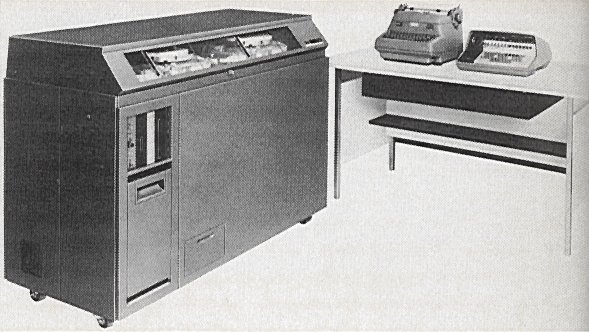The IBM 610 Auto-Point Computer was designed in the portholed attic of Watson Lab at Columbia University by John Lentz between 1948 and 1954 as the Personal Automatic Computer (PAC) and announced by IBM as the 610 Auto-Point in 1957¹. The IBM 610 was the first personal computer, in the sense that it was the first computer intended for use by one person (e.g. in an office) and controlled from a keyboard². The large cabinet contains a magnetic drum, the arithmetic control circuitry, a control panel, and separate paper-tape readers and punches for program and data (according to one former user, Russ Jensen, "The machine was programmed by a punched paper tape which duplicated itself in order to perform extra passes through the code". The IBM electric typewriter printed the output at 18 characters per second; the other device was the operator's keyboard for control and data entry, which incorporated a small cathode ray tube (two inches, 32×10 pixels) that could display the contents of any register. A "register" is any of 84 drum locations (31 digits plus sign). The control panel provides additional programming control (e.g. for creating subroutines, typically for trigonometric or other mathematical functions). Price: $55,000.00 (or rental at $1150/month, $460 academic). 180 units were produced.
Lentz said of the 610, "A novel approach to computer programming and control, used in the IBM 610 computer, allows the solution of complex problems by an operator whose only previous experience with computing has been the desk calculator. The machine's command structure is designed so that the operator can at all times communicate with the computer by a series of short sentence-type instructions closely resembling the steps of manual arithmetic solution. A type of floating-decimal operation called the 'auto-point' mode permits entry of data into storage locations with automatic positioning of the decimal point, without elaborate programming. The decimal point is automatically re-positioned during subsequent computation" (Reference 1).
Users said (Reference 2) the machine was affordable, reliable (95% uptime was typical), easy to program (it was one of the first -- if not the first -- computer that was programmable symbolically from a keyboard), handled floating-point arithmetic naturally, and did not require air conditioning or special power. Some, however, faulted it for its execution speed (e.g. 20 seconds to calculate a sine). But as Brennan says, "Far ahead of its time conceptually, the 610 presaged 'on-line' direct communication between individual and computer." When the 610 was discontinued (it was technologically obsolete from the start, due to the long delay in getting it to market), most sites replaced it with a 1620.
IBM produced several other personal computers in later years, including the 5100 and the CS-9000 before finally releasing its world-conquering PC in 1981 (the CS-9000 was ready before the PC but announced after it).


0 komentar:
Posting Komentar